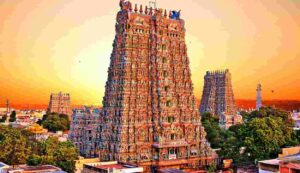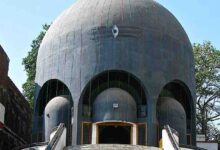Know about the interesting history and architecture of Meenakshi Amman Temple of Tamil Nadu
Meenakshi Amman Temple: One of the most well-known and exquisite temples in India is Meenakshi Temple, which is situated in the center of Madurai. Lord Shiva (Sundareshwara) and Goddess Parvati (Meenakshi) are the objects of devotion in this temple. Meenakshi Temple, a significant religious and cultural hub in Tamil Nadu, is renowned for its size, magnificence, and Dravidian architecture.

For the Tamil people, this temple is a well-known and iconic emblem of pride. This temple, located in the center of Madurai, a city that dates back 2,500 years, is described in Tamil literature.
We will provide you comprehensive information about Meenakshi Amman Temple in this post today. We’ll also inform you about the Meenakshi Amman Temple’s history. Read this article through to the conclusion to find out what the architecture of Meenakshi Amman Temple is, what its religious importance is, when it is open, and how to get there.
Meenakshi Temple’s History
With a history spanning more than 2500 years, the Madurai Meenakshi Temple is regarded as one of India’s oldest and most significant temples. Legend has it that the Pandya ruler Kulasekhara Pandya constructed the temple in the sixth century AD. The monarch begged Lord Shiva for a child since he was childless. He was fortunate enough to have a daughter, Meenakshi. She assumed control of the country at the age of 21 and reigned with tremendous wisdom and justice, being regarded as an embodiment of Goddess Parvati. Meenakshi later fell in love after meeting Lord Shiva. All of the gods and goddesses were present at their lavish wedding. To commemorate their union and pay homage to Goddess Meenakshi, this temple was constructed.
The most significant of the temple’s many extensions and modifications throughout the years was completed in the 16th century, under the Nayak dynasty’s rule. Huge gopurams, or gateway towers, which are regarded as some of the best specimens of Dravidian architecture, were added. The Madurai Meenakshi Temple is a well-liked tourist attraction and a significant Hindu pilgrimage site today. Covering 15 acres, the temple complex has 14 spectacular gopurams, each with elaborate sculptures and carvings. A testament to India’s rich cultural legacy, the Madurai Meenakshi Temple is a genuine architectural marvel.
Meenakshi Temple’s architecture
There is a huge temple on the 14-acre site in the center of Madurai. Following the assaults, extensive security measures were put in place around the shrine. From above, the whole edifice resembles a mandala. The geometric design of the mandala is founded on the ideas of location and symmetry. There are many temples throughout the compound. Although there are temples dedicated to other deities like Ganesha and Murugan, the two primary temples of the temple are Sundareswarar and Meenakshi. Numerous additional Hindu deities, such as Saraswati, Rukmini, and Goddess Lakshmi, call it home.
The temple’s hallowed pond is known as the “Potramarai Kulam.” In Tamil, “Potramarai Kulam” translates to “the pond with golden lotus.” A golden lotus sculpture serves as the pond’s focal point. Legend has it that Lord Shiva consecrated this pond and vowed that no marine life would ever thrive there as a result of his order. According to Tamil legend, a pond may evaluate any new work of literature based on its qualities.
The religious importance of the temple of Meenakshi
Goddess Meenakshi is shown in this temple with a parrot on her right hand. This temple is said to be one of the five locations where Shiva carried out Tandava. In contrast to the rest of the depiction of Nataraja, which shows his left leg lifted, a large silver statue of Lord Shiva in the shape of Nataraja is shown dancing with his right leg raised.
The festival of “Meenakshi Thirukalyanam,” or Meenakshi’s celestial marriage, is celebrated with tremendous fanfare every April. The Madurai marriage rite, which is dominated by women, is exemplified by this event. The chariot and float festivals are only two of the many activities that take place throughout this month-long celebration. Here, people also celebrate the holidays of Navratri and Shivaratri.
The Meenakshi Amman Temple’s location
By Air: Madurai has an airport with excellent connections to India’s main cities. To get to the temple from the airport, you may either take a bus or rent a cab.
By Train: Madurai Junction has excellent connections to all regions of the nation and is a significant railway station. To get to the temple from the station, you may either take a local bus or rent a cab.
By Road: TNSTC and commercial operators operate a large number of buses on Madurai’s well-developed road system. Bus tickets to Madurai are simply booked. Among the most popular bus routes to Madurai are those from Bengaluru and Chennai.
Autorickshaw: To go to the temple, you may rent an autorickshaw, which is a common form of transportation in Madurai.
Hours of the Meenakshi Amman Temple
- Meenakshi Amman Temple offers free admission and is open every day of the week. The temple’s darshan hours are from 4:30 AM to 12:30 PM and subsequently from 4:00 PM to 8:00 PM.
- Interesting Information Regarding the Temple of Sri Meenakshi
- The Sri Meenakshi Temple is regarded as the best example of Vijayanagara temple construction in South India.
- Actually, the temple is just as significant to South India’s artistic legacy.
- To North India, the Taj Mahal is
- Among the top 30 heritage nominees for the “New Seven Wonders of the World” was the Meenakshi Temple.
- There are an estimated 33,000 sculptures in the shrine.
- Since ancient times, the Meenakshi Temple has been referenced in Tamil literature.
In summary:
In the center of Madurai stands the Meenakshi Amman Temple. It is important to note that it is the largest temple complex in Tamil Nadu. Experts estimate that the temple was built in the first century B.C. Thirugnanasambandar, a Tamil poet and saint, made reference to this temple in early 6th-century Tamil writings. Up to the 17th century, the temple remained prosperous for generations.
Goddess Parvati, also called Meenakshi (the fish-eyed goddess), is the main divinity. Here, in contrast to other temples, adoration is offered to Lord Shiva and his spouse, Goddess Parvati. If you like this post, please read our other articles and forward this one to your friends.
